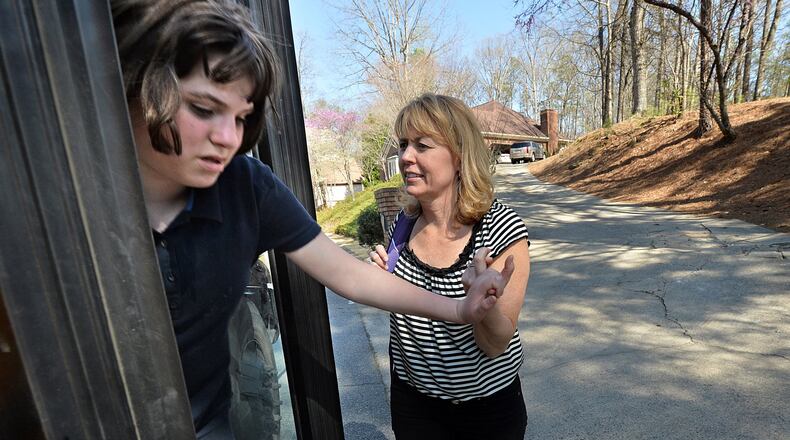Rebecca Cheskes’ 12 year-old daughter catches the school bus at 6 a.m., often in the dark, and doesn’t arrive at school until 7:15. In the afternoon, coming home takes about the same amount of time.
Her daughter, Dalia, who has a form of autism that leaves her unable to talk, has attended four different Fulton County schools – and none have been in her home community, Roswell. The specialized program she needs has always been at schools miles away.
"It's very isolating," said Cheskes. "How many adults commute for more than an hour? Not many."
Fulton County school officials hope a restructuring in the works will make that better for many students.
“We think we can do it better than how we’re doing it now,” said Cristy Smith, Fulton’s executive director of services for exceptional children.“We just need to make sure these programs are widespread enough that they’re readily available to families and children without significant busing or being far away from neighborhood peers.”
The long bus rides some of Georgia's most severely disabled students endure can hurt academic performance and leave them disconnected from friends and neighbors, parents and advocates say. They also say some students are unable to gain valuable learning experiences from non-disabled peers because they are segregated and receive little exposure to students who don't have disabilities.
Fulton’s move to add more programs for students with special needs comes as the U.S. Department of Justice continues its investigation into Georgia’s educational funding formula. That investigation was launched after the Southern Poverty Law Center filed a complaint in 2011 alleging the state’s schools were discriminating against students with disabilities. The complaint says Georgia’s funding formula encourages districts to segregate students with disabilities to collect more money. Georgia school districts receive more money when students with disabilities are taught in segregated classrooms — those set aside just for them — rather than traditional classrooms, the center contends.
Under federal law, students with disabilities are entitled to an education in the “least restrictive” setting from which they can benefit. “The least restrictive setting is typically understood to be the most integrated one,” said Margaret Nygren, executive director of the American Association of Intellectual and Developmental Disabilities.
“What happens over time when dollars become scarce, somebody does the math and figures out it’s advantageous to cluster the kids with disabilities in settings that are perhaps more segregated than they need to be for that individual student.”
Like Fulton, many school districts across Georgia, including metro Atlanta, bus some of the students with the most special needs to schools outside their communities. Advocates and parents are applauding Fulton’s efforts to decrease the busing and say the district is ahead of the curve compared to most other school systems in making the issue a priority.
“It’s hard to make friends … have a relationship when you’re not with the same group of kids that hang out in your neighborhood,” said Eric Jacobson, executive director for the Georgia Council on Developmental Disabilities, an independent state agency that advocates on behalf of families living with developmental disabilities. “Especially in the larger counties, you’ll still see some significant numbers being bused around.”
In Georgia, there are close to 185,000 children with disabilities, ages 3 to 21, who attend public schools, according to the Georgia Department of Education. Neither the state nor the U.S. DOE collects information about students with disabilities who ride buses or the length of their rides.
Special-needs advocates estimate hundreds of Georgia’s most severely disabled students throughout the state are bused out of their communities. In extreme cases, some students are on the bus up to two hours each way to school. Kids in rural areas, where resources and programs are more limited, can face particularly long bus rides, Jacobson said.
The U.S. DOE does monitor how much time students with disabilities spend in classrooms with students who don’t have disabilities.
“For that group that’s in general education more than 80 percent of the day, we’re at about 67 percent here in our state,” for 2011, said Deborah Gay, special education director for the Georgia DOE. “So when you look at how many of our students with disabilities are included in general education most of the day, it’s more than half of that population.
“I think we always strive to have children in the general education population as much as possible,” she said. “But children with disabilities do require specialized instruction, so that can be delivered in the general education classroom … in a pull-out class (outside general education class). Or it can be delivered in a separate school.”
Advocates say more school districts across the country in recent years have moved toward the type of structure that brings the services to those students — not busing kids out to those services.
At least one set of parents has filed a lawsuit against Fulton’s school system alleging education officials sought to remove their daughter, who has Down Syndrome, from a more inclusive elementary school setting around children without disabilities to a less inclusive school environment outside their home community.
In Fulton, there are about 9,800 students with disabilities and close to 350 – some of the most severely disabled students — are expected to be affected by the district’s plan to add more special-needs programs, said Smith. School officials hope to begin implementing the new plan in the fall of 2015.
Training teachers and offering services and needed programs will be crucial to the decentralization, parents and advocates say. So far, Fulton has not said how much the changes will cost.
Georgia’s graduation rate for disabled students is around 35 percent, and parents and advocates believe lengthy, arduous bus rides — in addition to students’ feelings of isolation and segregation — can contribute to the low rate.
Getting more of those students into schools in their communities in inclusive settings can increase that rate and bolster potential career opportunities after high school, parents and advocates say.
“If you take our kids with special needs out of the community, it’s a disservice to our child who is going to be living her whole life in the community, being supported by our community, hopefully getting a job in our community,” said Sandy Springs resident Patti Grayson, whose 12-year-old daughter has autism. The girl attended a school with a specialized program for two years outside of her community. Grayson and her husband fought – and won — to have her placed back in a school in her own neighborhood that offers specialized services she needs.
“I think it does a disservice to the typically developing kids in our community, if you take all the kids with disabilities out of the community. Then all of a sudden they grow up and they’ve never been around a kid with special needs. So they don’t know how to cope, how to talk to them. But if they all grow up together, they don’t think anything of it.”
About the Author
Keep Reading
The Latest
Featured

